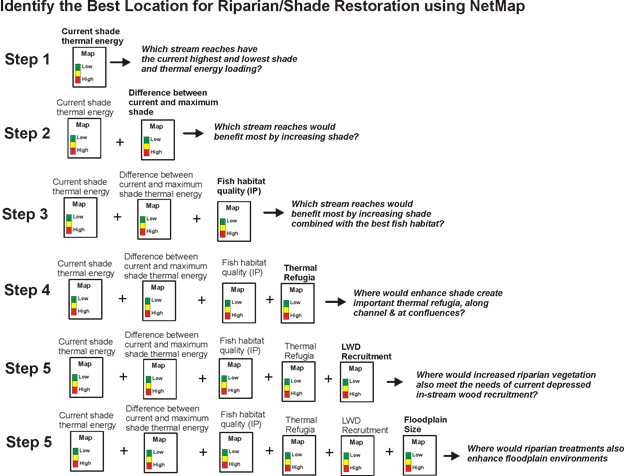| < Previous page | Next page > |
8.3 In-stream Wood RecruitmentNetMap contains two in-stream wood recruitment tools. The physically based wood recruitment models are based on wood budgeting and the extensive scientific literature on in-stream wood recruitment.
Reach Scale, Forest Growth: The Reach Scale Wood Recruitment Model (RSWM) calculates wood loading and accumulation in a reach based on vegetation mortality (generated in forest growth models or estimated) and decay. The model can be run for one or more years (running multiple years will require input from a forest growth model). The model runs independently of GIS, and can run independently of NetMap. A unique component of the reach scale wood model is the inclusion of tree tipping. See Abstract
A forest growth model coupled to a model of in-stream wood recruitment was used to explore riparian management alternatives in Douglas-fir plantations in coastal Oregon. Alternatives included: (1) no treatment, (2) single and double entry thinning from below, without and with a 10-m buffer, and (3) thinning combined with mechanical introduction of some portion of the thinned trees into the stream (tree tipping). Compared to no treatment, single and double entry thinnings on one side of a channel, without a 10-m buffer, reduce cumulative in-stream wood 33% and 42% respectively, after 100 years. Maintaining a 10-m buffer reduces the in-stream wood loss to 7% (single entry thin) and 11% (double entry). To completely offset the losses of in-stream wood in a single entry thin (on one or both sides of the stream), in the absence or presence of a 10-m buffer, requires a 12-14% rate of tree tipping. To completely offset the losses of in-stream wood in a double-entry thin, in the absence or presence of a 10-m buffer, requires a 7-10% rate of tree tipping. In contrast, relative to the no-treatment alternative, cumulative in-stream wood storage can be increased up to 24% in a double-entry thin with no buffer by tipping 15-20% of the thinned trees. Simultaneously thinning on both sides of the stream with no buffer doubles the predicted reductions while the same percent tipping doubles the increases. The predicted large increases in in-stream wood that can occur during a thin with tree tipping can be effective for restoring fish habitat, particularly in aquatic systems that have poor habitat conditions and low levels of in-stream wood due to historic land use activities. Thinning in riparian zones should be evaluated in the context of ecological settings and tradeoffs, including current and potential aquatic habitat conditions, natural wood recruitment processes, erosion risk, shade, thermal loading, forest stand successional trajectories, and economic returns from thinning operations. A watershed scale planning perspective that considers the full range of ecological settings is the best means to evaluate the full range of riparian management alternatives. See full paper draft here.
Watershed Scale Wood Recruitment: This tool allows a user to import remote sensing data on vegetation, such as LEMMA (or other customized data), and to predict the spatial variation in a single years wood recruitment potential based on variation in riparian forest tree diameters, heights, stand density and local topographic controls on wood recruitment (such as hillslope angle and channel width). Future versions of the tool will allow users to import spatially explicit forest growth predictions.
 |